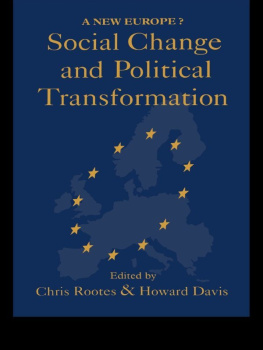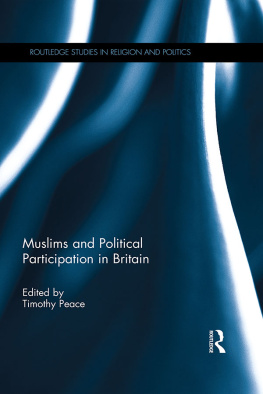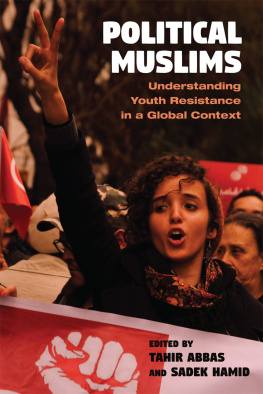Muslim European Youth
Reproducing ethnicity, religion, culture
Edited by
Steven Vertovec
Alisdair Rogers
First published 1998 by Ashgate Publishing
Reissued 2018 by Routledge
2 Park Square, Milton Park, Abingdon, Oxon, OX14 4RN
711 Third Avenue, New York, NY 10017, USA
Routledge is an imprint of the Taylor & Francis Group, an informa business
Copyright Steven Vertovec and Alisdair Rogers 1998
All rights reserved. No part of this book may be reprinted or reproduced or utilised in any form or by any electronic, mechanical, or other means, now known or hereafter invented, including photocopying and recording, or in any information storage or retrieval system, without permission in writing from the publishers.
Notice:
Product or corporate names may be trademarks or registered trademarks, and are used only for identification and explanation without intent to infringe.
Publishers Note
The publisher has gone to great lengths to ensure the quality of this reprint but points out that some imperfections in the original copies may be apparent.
Disclaimer
The publisher has made every effort to trace copyright holders and welcomes correspondence from those they have been unable to contact.
A Library of Congress record exists under LC control number: 98070995
ISBN 13: 978-1-138-32290-5 (hbk)
ISBN 13: 978-0-429-45173-7 (ebk)
Lenie Brouwer is Lecturer in Ethnic Studies, Free University of Amsterdam
Jocelyne Cesari is Charge de Recherches, Institute for the Research and Study of the Arab and Muslim World, Aix-en-Provence
Kaye Frances Hawe is Research Fellow, School of Education, University of Nottingham
Talip Kucukcan is Research Fellow, Centre for Research in Ethnic Relations, University of Warwick
Yvonne Mrck is Assistant Professor of Sociology, University of Copenhagen
Marie Parker-Jenkins is Professor of Research in Education, University of Derby
Lars Pedersen is a social anthropologist working with consultative assignments in inter-cultural research projects, Denmark
Alisdair Rogers is College Lecturer in Geography, University of Oxford
Yunas Samad is Lecturer in Sociology, University of Bradford
Thijl Sunicr is Research Fellow at the Research Centre for Religion and Society, University of Amsterdam
Steven Vertovec is Research Reader in Social Anthropology, University of Oxford
Lale Yalin-Heckmann is Resarch Fellow at the Chair of Turkish Studies, University of Bamberg
Steven Vertovec and Alisdair Rogers
Recently observed in a British city: an Asian man about twenty years old wearing sunglasses, baggy trousers, large trainers loosely laced, and a black T-shirt depicting a photo of the Earth from space under which appear the words ' dar al-Islam ' [the realm of Islam], Do these trappings merely mark a radical street style? Do they represent a new force of 'fundamentalism'? Do they indicate the retention of an identity across generations and continents, or a new mode of being Muslim that has been forged particularly in the British urban context, or some hybrid form of Islam sweeping Europe?
These possible, wide-ranging interpretations are only a few of many which have been widely rehearsed-by media journalists, academics and Muslim commentators alike-with regard to the myriad expressions of religious identity evident among young Muslims throughout Europe. The best interpretation is probably that such a combination of elements have no single 'message' or 'meaning'. Young European Muslims are increasingly demonstrating that there is no inherent contradiction or cognitive dissonance necessarily associated with having 'street-cred' and hip-hop style, identifying with certain contemporary global orientations within Islam, being for example British and Muslim and Pakistani, and perhaps being at the same time in accord with and at odds with the views and values of one's parents. This Introduction, along with the articles which comprise this volume, explores some of the multiple modes of expression and attachment which young Muslims in Europe are constructing today.
There are at least seven million Muslims currently living in Western Europe (Vertovec and Peach 1997). Although their families' roots may be in South Asia, the Maghreb, or Turkey, a large proportion of Europe's Muslim population-over half in many places (for example, 56% of Bangladeshis in Britain; Jones 1993)-is comprised of persons under twenty years old. They are Muslims who have been born, raised, schooled and who live in various European contexts. 'They are, in a sense,' writes Czarina Wilpert (1989: 6), 'new Europeans searching for a new belongingess and the right to new identities.' Despite their immigrant or 'ethnic' backgrounds, it is therefore fair to describe such persons as Muslim Europeans.
It is particularly the cohort of young Muslim Europeans who are presumed to have a problem with 'identity': yet the 'problem' is far more often in the mind of the non-Muslim (researchers and journalists not least), or the of the Muslim elder, than among the young people themselves. The set of examples below point toward some of the presumptions and complexities surrounding questions of young European Muslims and their 'identity'.
Fundamentalists, apostates or contextualists?
In June 1995, the northern English city of Bradford witnessed several nights of violence which saw police pitted against Asian young men. The police and much of the media put the blame on both a 'cultural gap' and 'generation gap' among the local Asian population: the 'westernized' youths-a generation caught 'between two cultures'-were deemed to be out of the control of their parents and 'Asian community leaders' (Burlet and Reid 1996). Some accounts even pointed to the alleged importance of 'Islamic militancy' in fostering the riots, despite the lack of any kind of evidence of Muslim symbolism surrounding the riot (McLoughlin 1997). It was somehow assumed, and readily accepted by many quarters of British society, that religious extremism must have had something to do with the disturbances, particularly in this city which was context to much of the controversial Satanic Verses protests in 1990.
Just after the riots, it was reported that the avowedly extremist organization Hizb-ut-Tahrir held meetings seeking new recruits from among the disaffected youths in the locale. Over the past few years, Hizb-ut-Tahrir itself has gained a notorious reputation for holding rallies and other activities at British universities at which anti-Jewish and anti-gay messages were propagated. Hence it seems to many that Muslim extremists are emerging both from the unemployed working class Asian youth of inner cities and from the population of intellectuals training at institutes of higher education.
A kind of moral panic concerning the imagined rise of home-grown Muslim extremists has not by any means been limited to Britain. Since the autumn of 1995, when the French police killed Khald Kelkal, the chief suspect in a terrorist bombing campaign, there has ensued a high degree of public debate about whether alienated French Muslim youth in run-down suburbs are turning to violent Islamicist groups and creating a rebel subculture (see Cesari this volume). In Germany a similar debate has followed the publication of Wilhelm Heitmeyer's (1997) Verlockender Fundamentalismus ['Enticing Fundamentalism']. In this book, based on arguably spurious research on the connections between German Turkish youth in Hamburg and the Milli Grs tradition of Islam (associated with the Islamist Refah party in Turkey), Heitmeyer claims there is a dangerous fundamentalist element growing within Germany.






